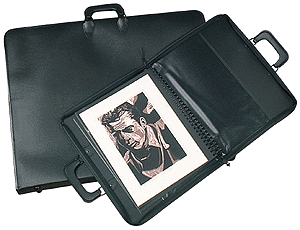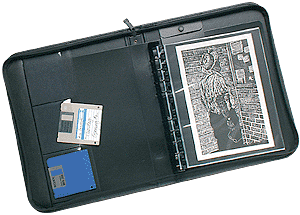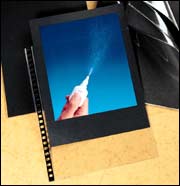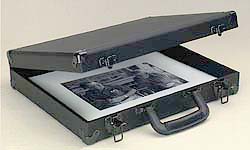 |
 |
 |
 |
 |
 |

A PROFESSIONAL PORTFOLIO OF YOUR DESIGN WORK
Your "portfolio" is your advertisement and calling card, which will illustrate to everyone who needs the design services which you are able to provide, why they should hire you for the job, instead of someone else. It is also required sometimes for admission or placement in graduate school or admission to upper levels of education at some institutions.
It is extremely important that your portfolio be neatly and professionally prepared, maintained and enlarged throughout your career.
The end product of this final project will be a personal portfolio that you will use in the future and expand on as you produce more high-quality design work. You should think of this project not as just another "hoop" to jump through, but as the beginning of a life-long process. It should also be looked at as an exercise in creativity, and a true design problem.
The portfolio is due on the scheduled day for the final exam and will take the place of a written exam. It is a "concordance" of all your work during the semester.
Requirements are as follows:
COVER SHEET designed and drawn by you, including your name and address, and a "logo" for yourself that would personalize your total work. You could create a photo-collage of your favorite visual image, building, interior, painting, photograph, movie, song, etc. for the cover sheet.
ONE PAGE WRITTEN INTRODUCTION TO YOU - kind of like a resume, but even better, in that it should be artistically composed and not just a compilation of a lot of statistics. SELL YOURSELF! Type this on word processor and print out neatly on the best quality of bond paper on the letter?quality printer or with a good typewriter.
Research the cost of photographing your work with several possible companies and sources, including both taking the pictures as well as developing and printing them. Use 8x10 glossy color or black and white photographs (with borders) as the standard for displaying your work.
Select a book and binder type that you will use. Research the cost of the various options, listing the pros and cons of each. Remember that "portfolio" comes from the root word "port" which means to carry. Whatever you do must be "portable." Most professionals consider the 11 1/2" x 14" page size the best since it will accommodate both horizontal and vertical format 8x10 photographs, however, the 8 1/2" x 11" page size is acceptable and may be more economical. The following are acceptable types:
Portfolio multi-ring (not three-ring) loose-leaf binder with replaceable pages. Most professionals consider this the best and most flexible format.
White plastic portfolio with clear acetate sleeves purchased from OfficeMax - 24 pages, maximum, although a beginner's portfolio need only be 12 pages
Large envelope
2 sheets of illustration board bound artistically with ribbons or string
Box or case containing individual pages


Select the MEDIA for your portfolio - be consistent in use throughout
Create the portfolio and
submit to your Instructor for your final project grade on the final exam day
and time. You will receive a grade from your instructor and he or she
will then return your portfolio to you. Do not leave without it.
Be sure to carry it in a plastic bag, envelope or box to keep it dry.
Always keep your portfolio in a dry and dust-proof case. You will have it for
a long time. Do not let it out of your sight!
Dos and Don'ts for Portfolios
1. Do only include your best work
2. Do keep it extremely simple
3. Do use Arial or sans serif type styles
4. Do put images only on right page
5. Do only use multi-ring binders or have Kinko's bind with coiled or multi-ring bindings
6. Do make pages only white or black
7. Do put a white sheet filling up the entire page behind any tracing paper sketches
8. Do put labels (if any) under the images only (not above or to the side)
9. Do orient images to read from the bottom of the page or from the right side
10. Do make portfolio 8 1/2" x 11" maximum size
11. Do use a single lens reflex camera with only 200 ASA or 100 ASA 35mm color print film to photograph models and have Kinko's enlarge to 8 x 10 or 8 1/2" x 11" size - have them print on glossy paper
12. Do use a pair of really, really bright halogen or incandescent (blue) lights to illuminate models
13. Do use a black sheet backdrop for photographing models
14. Do turn off any fluorescent lights nearby while taking photographs
15. Do make sure the picture is in really, really sharp focus
16. Do not photograph flat drawings - take to Kinkos to scan and print or put originals in
17. Do not use any lettering color other than black
18. Do not use any page color other than white
19. Do not use any page texture other than smooth and matte
20. Do not use borders around photographs
21. Do keep your portfolio in a dry and dust-proof case
22. Put your best work first in the portfolio - also, put best work last (*but not the same best work)
23. Keep everything in proportion - nothing too large and nothing too small
24. Do keep all images aligned with the edge of the page - do not rotate images
25. Keep CADD drawings and CADD renderings to a minimum - most schools don't want to see them (they look too technical), but if you are applying for a job where they are looking for CADD skills, include a variety of CADD drawings - 2d, 3d and renderings
Dos and Don'ts on Resumes
1. Do make it one
page long
2. Do compose it so it can easily be sent via email
3. Do use at least 12 point type, Aerial font
4. Do use both upper and lower case letters
5. Don't use fancy formatting - no italics, boldface, underlining, or
color
6. Don't use exclamation points to try to show how excited you will be
7. Do include this resume in your portfolio and keep extra copies to give
to your prospective employer
8. Do list your references and their addresses and telephone numbers
9. Do post it on a free web site which you should make for yourself -
list the web site address on your resume
10. Do register your resume with job web sites
11. Do include the following items:
Objectives
Qualifications
Experience with dates - last first
in list
Education
References
1. Communication Skills
2. Work Experience
3. Motivation - Initiative
4. Teamwork Skills
5. Leadership Abilities
6. GPA - Academic Credentials
7. Technical Skills
8. Interpersonal Skills
9. Analytical Skills
10. Ethics
Remember – you are creating a work of art in your portfolio. Treat is as such.